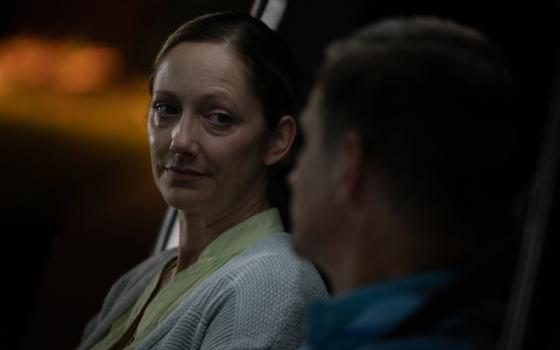
From left to right: Catholic TikTok users Chris Karroum, @chriskarroum; Amber-Rose Schneider, @the_religious_hippie; and Lana Michele, @faithfullylana (Provided photos)
When Amber-Rose Schneider first joined TikTok — the snappy, short-form social media app with more than 1 billion users worldwide — she wanted to see more young teenage creators like herself, who reflected her Catholic beliefs.
A self-described "cradle Catholic" and graphic design student at Liberty University, Schneider, now 21, began using her TikTok as "@the_religious_hippie," a fun moniker her friends gave her. She was posting casually, but had what she calls a "turning point" in her faith, and began posting openly about her beliefs.
"At first, I felt like I was the only Catholic," said Schneider, who now has nearly 90,000 followers. "But then I discovered people like me, from everywhere, with one thing in common: we all love God."
Even as its future in the U.S. remains unclear, the viral social media app continues to grow, especially among young users. Over half of TikTok's users are between ages 10 and 29. The app, first launched in China in 2016 before later merging with Musical.ly, showcases a newsfeed of simple, short-form entertainment videos made by creators themselves. People can also see algorithm-selected videos in their newsfeed, based on people, trends or hashtags they follow.
For young U.S. Catholics like Schneider, TikTok is more than an app for dances, funny memes and challenges in 60 seconds or less. It's a community dedicated to evangelizing and defending the faith as well as a place for networking and recreation, especially during the coronavirus pandemic, as more young people are seeking connection and answers in a particularly divisive year.
Advertisement
Even religious men and women have gotten in on the trend, using the time in quarantine to start posting more content and engage openly with followers: such as "viral" priests Fr. Frankie Cicero of Life Starts Here Ministries in Arizona and Simon Esshaki, a Chaldean priest in San Diego. Even the Netherlands-based Carmelite Sisters of the Divine Heart have nearly 243,000 followers; their comment sections are filled with people from other faiths thanking the nuns for their entertaining and wholesome content.
(In a @carmeldjc video from July, when a user asked, "What do you think about the LGBT community?" The nuns' simple reply was, "God loves everybody.")
"Catholic TikTok" is filled with diverse creators; they are mostly teens and young adults posting videos — church teachings and memes, real-life struggles and news takes — often with a filter, set to music or a track. Trending hashtags like #catholic and #catholicsoftiktok have more than 380 million views.
Those hashtags tend to attract TikTokers who identify as "rad-trad" or "traditionally Catholic," said 16-year-old Chris Karroum, who has more than 6,000 followers for his humor. Karroum said he started attending traditional Latin Mass after learning about it on the app.
Schneider also had a "very traditional" Catholic upbringing attending both Norvus Ordo and Latin Masses. Some of her most-viewed Catholic TikToks are openly about politics (including how she'll be voting in the upcoming election), being pro-life and conservative, and her opinions on the church.
While not branding themselves as social media "influencers" — a term usually reserved for those with a substantial following who are often paid for posting content — these media-savvy Catholics are unafraid to speak their mind. But along with the fun comes navigating judgment, negativity and vast differences online and within the faith.
When making TikToks on topics like the saints, modesty or the Blessed Mother, Schneider says people have lively discussions in the comment section, which is the point. If they want more information on a subject, they can watch her longer YouTube videos or start looking things up.
"It's important for my generation and younger to understand they're not alone," said Schneider. "I want to influence people to hold truth to their moral values ... to embrace their traditional Catholicism and not feel ashamed about that."
But experts warn that while social media fuels much-needed connection, especially during the pandemic, it can also become an "echo chamber" for one's own beliefs, or just one side of the story.
"There is so much out there with social media because everyone has equal access to multiple channels, making it incredibly loud. Sometimes it's hard to discern which voices are important and need to be heard," said Clarissa Valbuena Aljentera, author of The Parish Guide to Social Media: How social networking can recharge your ministry — written before TikTok even existed.
Alijentera believes it's the church's responsibility to meet people where they are, especially online, and that the church can social media to its advantage, when done correctly. Even as apps and websites change, fizzle out or gain popularity, it's about being intentional about your usage on social platforms where "issues of inequity, racism, violence and justice are seeing more traction these days," she said.
"We need to be aware of who we are and how we are online," she said. "As people really discern what they are posting for others to see, they should take into consideration if what they are sharing is reflective of Jesus. Or are they using that space to be mean, spiteful or unkind just because the platform is available?"
A community of outspoken Catholics
With thousands of views and followers, the TikTokers have their work cut out for them — using their platforms to answer difficult questions about the Eucharist, talking openly about the pope, and organizing campaigns like #defendthechurch, which has more than 4.5 million views.
The teens also make sure to have fun, repping group affiliations (ex. "Yee Yee Pierogi of the Sacred Heart," "Papist Peeps," "Papist Penguins," etc.) like fraternities on their profiles, along with an icon of the Vatican City flag. It's an inside joke, many of them said. The goal is to intrigue others with limited attention spans.
Lana Michele, known on TikTok as @faithfullylana, said the platform is a "less serious" way of getting people to talk about divisive topics like abortion or Scripture. It's also a way to find inspiration, hold each other up and accountable, especially when getting thousands of likes and views on your videos.
"I feel like people think of Catholics, or really any Christian, as someone who is straight-laced, but TikTok proves them wrong," said Michele, who hails from New York and also moderates a Catholic young adult community on Instagram, The New Gen of Catholics. "It's such a unique way to share the faith, through the form of dancing or jokes, and can allow you to be vulnerable in a creative way. It's so different than writing just a post or tweeting words, that it attracts young Catholics, who are the future of the church."
Many of the influencers are also part of a TikTok community formed during the quarantine, @est.33ad, named after the year the church was established, which features personal testimonies, church history and current events.
Evelyn Lundy, a @est.33ad member whose handle is @sunflowercatholic, says TikTok is "an amazing tool for spreading the gospel." She posts videos on modesty, apologetics and feminism that have racked thousands of views.
"I get a handful of messages every week from people telling me I've shown them a new perspective on Catholicism, and led them to question their preconceived notions of the faith," she said. "It's truly amazing to be able to help dismantle those misconceptions and share what the church is really about. The community is truly like no other."
Jacob Palchak, a 21-year-old student at the University of Southern California, makes Q&A-style videos that he says address misconceptions in the church. Known as @jacobforjesus, he has more than 30,000 followers. Since his content influences people, he feels a responsibility to "promote strong Catholic values and present accurate doctrines," he said.
TikTok priests are also learning the ins and outs of the trending platform.

Fr. Matt Lowry, the chaplain for the Newman Center at Northern Arizona University, is known as "the dancing TikTok priest." He says the Catholic Jacks page went viral during quarantine, and has been a fun and engaging way to connect with students. (Provided photo)
Fr. Matt Lowry, the chaplain for the Holy Trinity Catholic Newman Center at Northern Arizona University in Flagstaff, Arizona, says he went viral "by accident." Lowry is the face of Catholic Jacks (named after the school's mascot), which has gained more than 50,000 followers since June.
The young, self-described introverted priest says he is led by his students, whom he says have plenty of entertaining ideas: from minute-long homilies to fun dances.
"The students are so involved in TikTok culture, so I let them take the lead. I'm 13 years a priest, [but] working with college students keeps me young," Lowry said. "I'm not afraid to be goofy for the Lord."
Lowry says that evangelizing through TikTok has been an effective way to get public attention on campus, especially for bringing more people to the university's Newman club. More students are comfortable approaching him. Several media outlets have called him "the TikTok priest."
"People are coming to us with raw, real questions, looking for integrity, and that's where Jesus wants us to go," he said. "If this can somehow start a conversation or be a splinter in someone's brain bringing them joy and closer to Christ, then we accomplished what we're setting out to do."
[Allyson Escobar is a journalist from the greater Los Angeles area and a graduate of the City University of New York's journalism school. Her work has appeared in national and Catholic publications including NBC News, the Los Angeles Times, America Magazine, The Tablet and Angelus News.]



